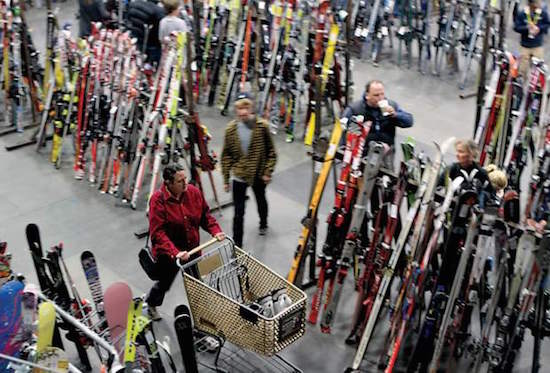Let me start out by saying I’m writing this in advance. When I hit the publish button on January 28, I’ll be in Jackson Hole with the Ski Divas for our annual Diva West adventure (I’ll write about that another time). And though I’m anticipating a really fun time — it’s always a blast — I’m hoping I don’t have a rerun of last year’s luggage disaster, when American Airlines lost our skis.
In a nutshell, this is what happened: We flew from Boston to Chicago, where we changed planes for Aspen. And though we made our connection just fine, our big honking double ski bag didn’t. Sure, it got to Chicago, but after that it completely dropped off the radar. American couldn’t find it for four very long days. When the bag finally turned up, American sent it to us by Fed Ex (which I still don’t understand; doesn’t American have planes?)….and Fed Ex lost it, too. Eventually, the ski bag turned up at Fed Ex’s Lost and Found in Memphis, TN, minus any of our ID or tracking info from American Airlines. An enterprising guy at the Fed Ex facility managed to track us down through some information my husband had tucked inside the bag. We were just about ready to come home when it finally showed up at our rented condo.
Which leads me to today’s topic: What exactly are our rights, when the airline loses our skis?
It seems like no one is really sure. Airline policies seem to be all over the place. We were lucky. American was pretty decent about the whole thing: we were compensated for our ski rentals and for the clothing we bought to tide us over so we could ski. That said, you actually do have rights. According to Travelers United, a non-profit bi-partisan group that represents travelers, you’re entitled to the following:
1. $3,500 compensation for damaged, delayed, or lost checked baggage on domestic flights
If a passenger’s checked luggage is lost, delayed, or damaged, airlines are responsible for up to $3,500 in compensation from the airlines. If delayed baggage requires a passenger to purchase or rent items, such as skis or ski boots, or clothing to wear during travels, this falls under this rule. If luggage is damaged, including handles and straps, this rule comes into effect. And, when luggage is lost, the maximum claim that the airlines have to honor is $3,500.
Passengers are responsible for producing a list of items lost, damaged or delayed. And they should be prepared to have receipts for purchases during their trip in the case of delayed baggage. For compensation of a lost bag, reasonable costs for clothing will be accepted by airlines. One method of dealing with this is to take a picture of the contents of your bag before packing. If receipts for some high-value items are available, so much the better. Also, be prepared to accept the depreciated value of lost items.
Fragile items such as cameras, computers, glassware, jewelry, and so on, can be excluded from the compensation by the airlines on domestic flights.
With proper documentation, most airlines will pay the requested claim up to the compensation level of $3,500. When the luggage is lost, passengers are also due a return of any checked-baggage fees paid to the airline.
2. About $1,580 of compensation is due for lost, damaged, or delayed checked international baggage.
Follow the same rules for claims for domestic flights when international luggage is lost, delayed or damaged. The big differences between compensation for international flights (including connecting segments of domestic flights on the same itinerary) is that the compensation is set by the Montreal Convention, an international airline treaty. It is based on “special drawing rights (SDR).” That amount is set at 1131 SDRs (about $1,583).
Delayed and damaged baggage is limited to 17 SDRs per kilogram per passenger for checked baggage (about $400 for a 35 lb. bag) and a total of 332 SDRs for unchecked baggage.
Fragile items such as cameras, computers, glassware, jewelry, and so on are included in the items for which compensation must be paid on international flights under the Montreal Convention. Here is list of countries that are party to the Montreal Convention.
3. Read your airline’s rules for reporting lost, damaged, or delayed baggage.
In every case, do not leave the airport prior to reporting the mishandled baggage to the airline. Without your claim tag and a report at the airport, it will be virtually impossible to get compensation for lost luggage or for costs associated with delayed baggage. Damage to contents of your luggage should be reported as soon as it is discovered.
4. Check with your household goods insurance company.
Many times your personal insurance company will cover you for lost, delayed and damaged items during travels. In many cases credit card companies insure items purchased with their credit cards from damage, even during travels. (There’s a nice credit card benefit most people don’t even know they have.)
Here are some other ways to minimize your pain:
Never, never, ever check your boots. Always bring them on board the flight with you, along with a set of ski clothes you can wear for a day. It’s okay to rent skis — we did, and it’s a great demo opportunity — but skiing in a pair of rental boots? No fun. Think of all the hours you spent dialing in the fit for your boots. Do you really want to take the chance that that’ll be gone forever?
Tag everything, both outside and in. The only way Fed Ex was able to ID us was through an address tag we put inside our ski bag. If our name and cell phone number weren’t inside, they never would’ve found us.
Stay on it. Our misadventure required multiple phone calls to American Airlines with a constantly revolving cast of characters. Each one required a new explanation about what had happened, as well as an update on what the previous airline rep had said or promised. Keep good notes. You’ll need them.
GET TRAVEL INSURANCE: I can’t emphasize this enough. It’s well worth the investment. We actually have an annual travel insurance from Nationwide, so we don’t even have to think about it from one trip to the next.
Here’s the best advice
In all the years I’ve flown on ski trips, my gear has only been lost twice. I consider myself lucky. In both cases, it was ultimately found. The first time it took a matter of hours, and the second, as I outlined above, it took a few days. But it DID turn up. So if your gear disappears, don’t panic. Be patient, keep your cool with the airline reps (you’ll get better results; remember, they’re just trying to do their jobs), and cross your fingers. Don’t let it ruin your trip. Remember, it’s just stuff, and it’ll either be found or you’ll get some compensation. I know it’s a pain in the neck to deal with, but you can still have a good time. In the end, it’ll work out.



